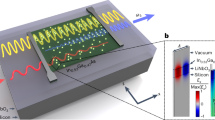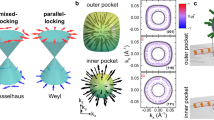Abstract
Controlling the direction of light emission on the subwavelength scale is a key capability for quantum information processing and optical imaging in photonics and biology1,2,3,4,5. The spin–orbit interaction of light is widely adopted for dynamically tuning the direction of circularly polarized photoluminescence (PL), but this is challenging to accomplish for many luminescence materials, which typically generate unpolarized luminescence. Here, we report optical control of unidirectional emission of unpolarized luminescence in a spatially symmetric nanopillar lattice assisted by photonic orbital angular momenta. The orientation of anti-Stokes shift PL emissions can be controlled by the helicity of incident vortex beams. The experimental directionality of unpolarized PL emission in the one-dimensional nanopillar lattice can reach 0.59, which is markedly stronger than that possible by a spin mechanism. Our findings thus offer a new promising approach for tuneable nanoscale optical control of emission.
This is a preview of subscription content, access via your institution
Access options
Access Nature and 54 other Nature Portfolio journals
Get Nature+, our best-value online-access subscription
$29.99 / 30 days
cancel any time
Subscribe to this journal
Receive 12 print issues and online access
$209.00 per year
only $17.42 per issue
Buy this article
- Purchase on Springer Link
- Instant access to full article PDF
Prices may be subject to local taxes which are calculated during checkout




Similar content being viewed by others
Data availability
The data that support the findings of this study are available from the corresponding authors upon reasonable request.
References
Lodahl, P. et al. Chiral quantum optics. Nature 541, 473–480 (2017).
Feng, L. et al. Experimental demonstration of a unidirectional reflectionless parity-time metamaterial at optical frequencies. Nat. Mater. 12, 108–113 (2013).
Curto, A. G. et al. Unidirectional emission of a quantum dot coupled to a nanoantenna. Science 329, 930–933 (2010).
Cihan, A. F., Curto, A. G., Raza, S., Kik, P. G. & Brongersma, M. L. Silicon Mie resonators for highly directional light emission from monolayer MoS2. Nat. Photon. 12, 284–290 (2018).
Iyer, P. P. et al. Unidirectional luminescence from InGaN/GaN quantum-well metasurfaces. Nat. Photon. 14, 543–548 (2020).
Rong, K. et al. Photonic Rashba effect from quantum emitters mediated by a Berry-phase defective photonic crystal. Nat. Nanotechnol. 15, 927–933 (2020).
Bliokh, K. Y., Rodriguez-Fortuno, F. J., Nori, F. & Zayats, A. V. Spin–orbit interactions of light. Nat. Photon. 9, 796–808 (2015).
Petersen, J., Volz, J. & Rauschenbeutel, A. Chiral nanophotonic waveguide interface based on spin-orbit interaction of light. Science 346, 67–71 (2014).
Pan, D., Wei, H., Gao, L. & Xu, H. Strong spin-orbit interaction of light in plasmonic nanostructures and nanocircuits. Phys. Rev. Lett. 117, 166803 (2016).
Rodríguez-Fortuño, F. J. et al. Near-field interference for the unidirectional excitation of electromagnetic guided modes. Science 340, 328–330 (2013).
Barik, S. et al. A topological quantum optics interface. Science 359, 666–668 (2018).
Guo, Q. et al. Routing a chiral Raman signal based on spin-orbit interaction of light. Phys. Rev. Lett. 123, 183903 (2019).
Gong, S.-H., Alpeggiani, F., Sciacca, B., Garnett, E. C. & Kuipers, L. Nanoscale chiral valley-photon interface through optical spin-orbit coupling. Science 359, 443–447 (2018).
Shreiner, R., Hao, K., Butcher, A. & High, A. A. Electrically controllable chirality in a nanophotonic interface with a two-dimensional semiconductor. Nat. Photon. 16, 330–336 (2022).
Sun, L. et al. Separation of valley excitons in a MoS2 monolayer using a subwavelength asymmetric groove array. Nat. Photon. 13, 180–184 (2019).
Liu, W. et al. Generation of helical topological exciton-polaritons. Science 370, 600–604 (2020).
Deng, Y. et al. Circularly polarized luminescence from organic micro-/nano-structures. Light: Sci. Appl. 10, 1–18 (2021).
Coles, R. et al. Chirality of nanophotonic waveguide with embedded quantum emitter for unidirectional spin transfer. Nat. Commun. 7, 11183 (2016).
Uchida, M. & Tonomura, A. Generation of electron beams carrying orbital angular momentum. Nature 464, 737–739 (2010).
Jiang, X., Li, Y., Liang, B., Cheng, J.-C. & Zhang, L. Convert acoustic resonances to orbital angular momentum. Phys. Rev. Lett. 117, 034301 (2016).
Luski, A. et al. Vortex beams of atoms and molecules. Science 373, 1105–1109 (2021).
Allen, L., Beijersbergen, M. W., Spreeuw, R. J. C. & Woerdman, J. P. Orbital angular-momentum of light and the transformation of Laguerre–Gaussian laser modes. Phys. Rev. A 45, 8185–8189 (1992).
Ni, J. et al. Gigantic vortical differential scattering as a monochromatic probe for multiscale chiral structures. Proc. Natl Acad. Sci. USA 118, e2020055118 (2021).
Ji, Z. et al. Photocurrent detection of the orbital angular momentum of light. Science 368, 763–767 (2020).
Yao, A. M. & Padgett, M. J. Orbital angular momentum: origins, behavior and applications. Adv. Opt. Photon. 3, 161–204 (2011).
Ouyang, X. et al. Synthetic helical dichroism for six-dimensional optical orbital angular momentum multiplexing. Nat. Photon. 15, 901–907 (2021).
Miao, P. et al. Orbital angular momentum microlaser. Science 353, 464–467 (2016).
Zhang, Z. et al. Tunable topological charge vortex microlaser. Science 368, 760–763 (2020).
Ren, H. et al. Orbital-angular-momentum-controlled hybrid nanowire circuit. Nano Lett. 21, 6220–6227 (2021).
Bliokh, K. Y. Geometrical optics of beams with vortices: Berry phase and orbital angular momentum Hall effect. Phys. Rev. Lett. 97, 043901 (2006).
Garbin, V. et al. Mie scattering distinguishes the topological charge of an optical vortex: a homage to Gustav Mie. New J. Phys. 11, 013046 (2009).
Devlin, R. C., Ambrosio, A., Rubin, N. A., Mueller, J. B. & Capasso, F. Arbitrary spin-to-orbital angular momentum conversion of light. Science 358, 896–901 (2017).
Inoue, T. & Hori, H. Theoretical treatment of electric and magnetic multipole radiation near a planar dielectric surface based on angular spectrum representation of vector field. Opt. Rev. 5, 295–302 (1998).
McArthur, D., Yao, A. M. & Papoff, F. Scattering of light with angular momentum from an array of particles. Phys. Rev. Research 2, 013100 (2020).
Ni, J. et al. Multidimensional phase singularities in nanophotonics. Science 374, eabj0039 (2021).
Qiao, X. et al. Higher-dimensional supersymmetric microlaser arrays. Science 372, 403–408 (2021).
Ren, H., Li, X., Zhang, Q. & Gu, M. On-chip noninterference angular momentum multiplexing of broadband light. Science 352, 805–809 (2016).
Kruk, S. et al. Nonlinear light generation in topological nanostructures. Nat. Nanotechnol. 14, 126–130 (2019).
Jin, Z. et al. Phyllotaxis-inspired nanosieves with multiplexed orbital angular momentum. eLight 1, 5 (2021).
Acknowledgements
This work was supported by the National Natural Science Foundation of China (Grant Nos. 61927814, 52122511, 52075516, 61805230, 62105319 and U20A20290; W.D., J.L., S.J. and Y.H.), the USTC Research Funds of the Double First-Class Initiative (Grant No. YD2090002005; W.D.), the National Key R&D Program of China (Grant No. 2021YFF0502700; W.D.) and the Foundation of Equipment Development Department (Grant No. 6140922010901; W.D.). J.N. acknowledges support from the start-up funding of the University of Science and Technology of China and the CAS Talents Program. We thank the USTC Center for Micro and Nanoscale Research and Fabrication. C.W.Q. is supported by the National Research Foundation, Prime Minister’s Office, Singapore under Competitive Research Program Award NRF-CRP22-2019-0006.
Author information
Authors and Affiliations
Contributions
J.N. and C.W.Q. conceived the idea and developed the theory. S.J., S.L. and Z.W. performed the experiments. J.N. performed the simulations. J.N., Y.C., X.L. and S.J. analysed the data. J.N., C.W.Q. and D.W. wrote the manuscript. C.W.Q. and D.W. supervised the project. All authors discussed the results and commented on the manuscript.
Corresponding authors
Ethics declarations
Competing interests
The authors declare no competing interests.
Peer review
Peer review information
Nature Photonics thanks the anonymous reviewers for their contribution to the peer review of this work.
Additional information
Publisher’s note Springer Nature remains neutral with regard to jurisdictional claims in published maps and institutional affiliations.
Supplementary information
Supplementary Information
Supplementary Figs. 1–17, Notes 1–6, Table 1 and References.
Rights and permissions
Springer Nature or its licensor (e.g. a society or other partner) holds exclusive rights to this article under a publishing agreement with the author(s) or other rightsholder(s); author self-archiving of the accepted manuscript version of this article is solely governed by the terms of such publishing agreement and applicable law.
About this article
Cite this article
Ni, J., Ji, S., Wang, Z. et al. Unidirectional unpolarized luminescence emission via vortex excitation. Nat. Photon. 17, 601–606 (2023). https://doi.org/10.1038/s41566-023-01226-9
Received:
Accepted:
Published:
Issue Date:
DOI: https://doi.org/10.1038/s41566-023-01226-9



